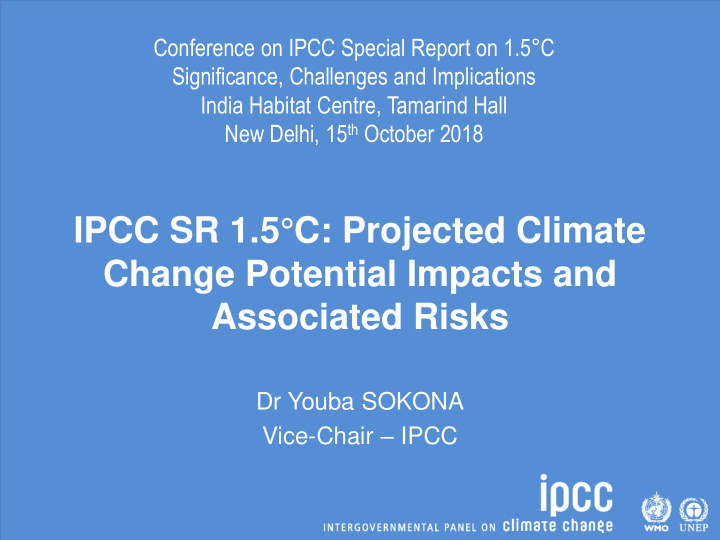



Conference on IPCC Special Report on 1.5°C Significance, Challenges and Implications India Habitat Centre, Tamarind Hall New Delhi, 15 th October 2018 IPCC SR 1.5°C: Projected Climate Change Potential Impacts and Associated Risks Dr Youba SOKONA Vice-Chair – IPCC
Key findings Climate change is already affecting people, ecosystems and livelihoods all around the world Limiting warming to 1.5c is not impossible but would require unprecedented transitions in all aspects of society There are clear benefits to keeping warming to 1.5c compared to 2c, or higher. Every bit of warming matters Limiting warming to 1.5c can go hand-in- hand with achieving other world goals, such as achieving sustainable developments and eradicating poverty
Projected climate change between 1.5°C and 2°C • Increases in mean temperature in most land and ocean regions • Hot extremes in most inhabited regions • Probability of drought and precipitation deficit in some regions • Heavy precipitation with tropical cyclones • Increases in fraction of the global land area affected by flood hazards
Mean temperature and mean precipitation changes 1.5°C vs 2° global warming
Change in temperature of hottest days and change in extreme precipitation 1.5°C vs 2°C global warming
Sea level rise and associated risks 1.5°C vs 2°C global warming • Global mean sea level rise around 0.1 m by 2100 – 10 million fewer people exposed to risk of rising sea • Sea level will continue to rise well beyond 2100 and magnitude and rate of rise depends on future emission pathways • Exposure of Small Islands, low-lying coastal areas and deltas • Increased saltwater intrusion, flooding and damage to infrastructure • Opportunities for adaptation in human and ecological systems
Risks for terrestrial and wetland ecosystems 1.5°C vs 2°C global warming • Lower impact on biodiversity loss and species extinction • Lower impacts on terrestrial, freshwater, and coastal ecosystems and to retain services to humans • Transformation of land area and area at risk 50% lower • Degradation and loss of high-latitude tundra and boreal forests • An estimated 1.5 – 2.5 million square km more permafrost will thaw over centuries with release of methane
Risks for ocean ecosystems 1.5°C vs 2°C global warming • Increases in ocean temperature, acidity, and decreases in oxygen levels – Sea-ice-free Artic Ocean during summer is substantially lower – Shift in ranges of many marine species to higher latitudes and increase damage to many ecosystems • Reduction in marine biodiversity, fisheries, and ecosystems and functions and services to humans – Loss of coastal resources, and reduce productivity of fisheries and aquaculture – Large losses of coral reefs
Risks for human systems 1.5°C vs 2°C global warming • Livelihoods and human security – Disadvantaged and vulnerable population dependent on agricultural or coastal livelihoods – Artic ecosystems, dryland regions, SIDs and LDCs – Increase number of people both exposed and susceptible to poverty by up to hundred million by 2050 • Human health – Lower risks for heat related morbidity and mortality – Amplification by urban heat islands of heatwaves in cities – Increase of vector-borne diseases such as malaria and dengue fever with potential shifts in geographic range
Risks for food security and water 1.5°C vs 2°C global warming • Food security – Reductions in yields of maize, rice, wheat and potentially other cereal crops particularly in sub-Saharan Africa, Southeast Asia, and Central and South America – Reduction of food availability in Sahel, Southern Africa, the Mediterranean, Central Europe and the Amazon – Low feed quality, spread of diseases and water availability for livestock • Reduction of population exposed to a climate – induced increase in water stress by up to 50%
Risks for economic growth 1.5°C vs 2°C global warming • Low impact on global aggregated economic growth by end of the century • Larger impact on economic growth in countries in the tropics and Southern Hemisphere, subtropics • Increase exposure to multiple and compound climate-related risks of poor people in Africa and Asia • Spatially and temporally overlaps of risks across energy, food, and water sectors
THANK YOU FOR YOUR ATTENTION! For more information: Website: http://ipcc.ch/ IPCC Secretariat: ipcc-sec@wmo.int IPCC Press Office: ipcc-media@wmo.int Find us on: IPCC @IPCC_CH IPCC https://www.linkedin.com/company/ipcc http://www.slideshare.net/ipcc- https://www.flickr.com/photos/ipccphoto/sets/ media/presentations https://www.youtube.com/c/ipccgeneva https://vimeo.com/ipcc
Recommend
More recommend